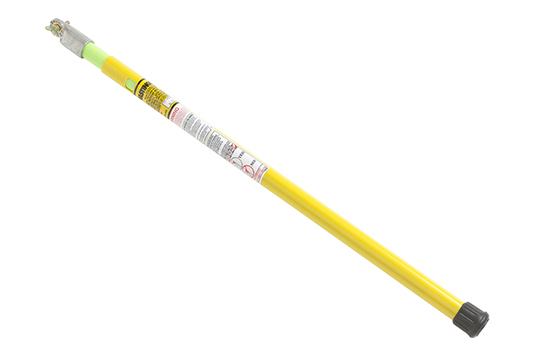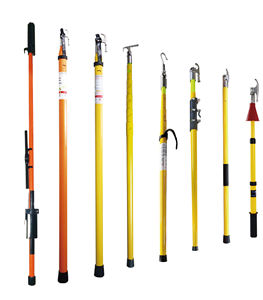High voltage hot sticks are essential tools for safely working on live electrical lines. They protect workers from electric shock.
High voltage hot sticks, also known as insulating sticks, are crucial for electrical utility workers. These tools enable safe handling of live electrical components. Made from materials like fiberglass, they provide insulation and prevent electric shocks. Workers use them to operate switches, install equipment, and perform maintenance on high voltage lines.
Their lightweight and durable design ensures ease of use and reliability in critical operations. Proper training and regular inspection of hot sticks are vital for maintaining safety standards. High voltage hot sticks are indispensable for ensuring the safety and efficiency of electrical maintenance tasks.

Credit: www.amprobe.com
Introduction To High Voltage Hot Sticks
High voltage hot sticks are essential tools for electrical workers. They ensure safety while working with high voltage lines. These tools allow workers to handle live wires without direct contact. Their use prevents electrical shocks and injuries.
Importance In Electrical Safety
High voltage hot sticks play a crucial role in electrical safety. They provide a safe distance between the worker and live wires. This distance reduces the risk of electric shock. Hot sticks are made from non-conductive materials like fiberglass. This ensures they do not conduct electricity. Using these tools, workers can perform tasks like opening switches and removing fuses safely.
- Prevents electrical shock.
- Keeps workers at a safe distance.
- Made from non-conductive materials.
Historical Development
The development of high voltage hot sticks has evolved over the years. Early versions were simply wooden poles. These poles were treated to resist electricity. Modern hot sticks are made from advanced materials. These materials are lightweight and more durable. Today, hot sticks come in various lengths and designs. They cater to different electrical tasks and safety requirements.
| Era | Material | Features |
|---|---|---|
| Early Years | Wood | Basic insulation |
| Modern Era | Fiberglass | Lightweight and durable |
Understanding the importance and history of hot sticks helps in appreciating their role. These tools are indispensable in the electrical industry. They ensure safety and efficiency in high voltage work.
Types Of Hot Sticks
High voltage hot sticks are essential tools for electrical workers. They help in safely handling live electrical equipment. There are different types of hot sticks. Each type has its own unique features. Let’s explore the most common types.
Telescopic Hot Sticks
Telescopic hot sticks are adjustable. They can extend to different lengths. This makes them versatile. Workers can use them for various tasks. These sticks are lightweight. They are easy to carry. They are also durable. Telescopic hot sticks are often made from fiberglass. This material provides insulation. It keeps the worker safe from electric shocks.
Shotgun Hot Sticks
Shotgun hot sticks are another popular type. They have a gripping mechanism. This allows workers to grab and hold objects. The gripping mechanism works like a shotgun. It opens and closes with a trigger. Shotgun hot sticks are useful for replacing fuses. They can also be used to open and close switches. They are strong and reliable. This makes them a favorite among line workers.
Materials And Design
High voltage hot sticks are crucial tools for electrical safety. Their design and materials ensure reliability and user safety. This section delves into the key aspects of their construction and ergonomic features.
Fiberglass Construction
Fiberglass is a preferred material for hot sticks. It offers excellent insulation properties. Fiberglass is also lightweight and strong, making it easy to handle.
The material is resistant to moisture and chemicals. This ensures longevity and durability in various environments. Fiberglass hot sticks are designed to withstand high voltage, providing safety for users.
Ergonomic Design
An ergonomic design enhances the usability of hot sticks. The handles are crafted to fit comfortably in the hand. This reduces hand fatigue during extended use.
Many hot sticks feature a non-slip grip. This ensures a firm hold, even in wet conditions. The design often includes telescoping features for adjustable length. This allows for versatility and ease of use in different situations.
| Feature | Benefit |
|---|---|
| Fiberglass Material | High Insulation, Lightweight |
| Non-Slip Grip | Improved Safety |
| Telescoping Design | Adjustable Length |
Usage Techniques
High voltage hot sticks are essential tools for electrical safety. Knowing the right techniques ensures safe and effective use. This section will cover how to handle them and their common applications.
Proper Handling
Handling high voltage hot sticks correctly is crucial. Follow these steps:
- Inspect the Stick: Check for cracks and dirt before use.
- Wear Safety Gear: Always wear gloves and protective clothing.
- Maintain Distance: Keep a safe distance from the power source.
- Use Both Hands: Hold the stick firmly with both hands.
Proper handling prevents accidents and ensures your safety.
Common Applications
High voltage hot sticks are used in various tasks. Here are some common applications:
- Switch Operation: They help operate switches from a safe distance.
- Fuse Replacement: Replace fuses without direct contact.
- Line Testing: Test power lines for voltage safely.
- Cleaning Insulators: Clean insulators on live lines.
These tasks are essential for electrical maintenance and safety.
Maintenance And Inspection
Proper maintenance and inspection of high voltage hot sticks are crucial for worker safety. These tools ensure protection from electrical hazards. Regular checks and proper storage extend their lifespan.
Routine Checks
Conducting routine checks is essential for the safety of high voltage hot sticks. Follow these steps for effective inspection:
- Visually inspect the hot stick for cracks or damage.
- Check for any contamination on the surface.
- Ensure the labels and markings are legible.
- Test the hot stick’s integrity using a dielectric test.
Perform these checks before and after each use. This ensures the tool’s reliability and safety.
Storage Guidelines
Proper storage of high voltage hot sticks prevents damage and contamination. Follow these guidelines to store your hot sticks correctly:
- Store hot sticks in a clean, dry place.
- Keep them away from direct sunlight and extreme temperatures.
- Use protective bags or cases for storage.
- Hang hot sticks vertically to prevent warping.
Adhering to these storage guidelines ensures the longevity and safety of your high voltage hot sticks.

Credit: www.roadware.co.uk
Safety Protocols
Working with high voltage hot sticks is dangerous. Following safety protocols is crucial. This ensures the safety of workers and the environment. Here, we discuss essential safety measures.
Personal Protective Equipment
Always wear personal protective equipment (PPE). This includes insulated gloves, helmets, and safety glasses. These items protect against electrical shocks and injuries.
- Insulated Gloves: Prevents direct contact with high voltage.
- Helmets: Shields the head from falling objects.
- Safety Glasses: Protects eyes from debris and sparks.
Environmental Considerations
Assess the environment before using hot sticks. Ensure the area is free from moisture. Wet conditions increase the risk of electrical hazards.
| Condition | Action |
|---|---|
| Wet Ground | Avoid the area |
| Nearby Trees | Clear the area |
| Windy Weather | Secure equipment |
Always keep a safe distance from other electrical equipment. This minimizes the risk of accidental contact.
Training And Certification
Proper training and certification are crucial for anyone using high voltage hot sticks. These tools ensure safety while working with high voltage electrical systems. Understanding the training programs and certification requirements is essential for every technician.
Training Programs
Training programs teach the safe use of high voltage hot sticks. These programs include practical and theoretical lessons. They cover topics like:
- Safety protocols
- Proper handling techniques
- Maintenance procedures
- Emergency responses
Professional trainers lead these sessions. They ensure every participant understands the importance of safety. Hands-on practice is a key part of these training programs. It helps technicians gain confidence in using high voltage hot sticks.
Certification Requirements
Certification verifies a technician’s ability to use high voltage hot sticks safely. The certification process includes:
- Completion of a recognized training program
- Passing a written exam
- Demonstrating practical skills
The written exam tests knowledge on safety protocols and tool handling. Practical skill assessments ensure technicians can use the tools correctly. Certified technicians must renew their certification regularly. This ensures they stay updated with the latest safety standards and practices.
Employers often require certification for technicians handling high voltage equipment. It provides assurance of the technician’s competence and commitment to safety.

Credit: www.mitchellinstrument.com
Future Trends
The future of High Voltage Hot Sticks is shaping up with exciting advancements. Emerging technologies and changing regulations are setting new benchmarks. These trends will redefine the safety and efficiency of electrical work.
Technological Advancements
Technological advancements are transforming High Voltage Hot Sticks. Manufacturers are incorporating smart sensors. These sensors can detect voltage levels and provide real-time data. This enhances safety for electrical workers.
Another innovation is the use of lightweight materials. New composites make hot sticks lighter and easier to handle. This reduces worker fatigue and increases productivity.
Wireless connectivity is also a game-changer. Hot sticks can now connect to mobile devices. This allows for remote monitoring and control, adding another layer of safety.
Regulatory Changes
Regulatory changes are also influencing the future of High Voltage Hot Sticks. New standards are being set for material quality and electrical insulation. Compliance with these standards ensures the highest safety levels.
Environmental regulations are becoming stricter. Manufacturers must now use eco-friendly materials. This reduces the environmental impact of producing hot sticks.
Worker safety regulations are also evolving. Employers must provide better training and equipment. This includes the latest high voltage hot sticks, ensuring worker safety.
| Trend | Description |
|---|---|
| Smart Sensors | Detect voltage levels, provide real-time data |
| Lightweight Materials | Reduce fatigue, increase productivity |
| Wireless Connectivity | Remote monitoring and control |
| Material Quality Standards | Ensure highest safety levels |
| Eco-friendly Materials | Reduce environmental impact |
| Enhanced Training | Improve worker safety |
Frequently Asked Questions
What Is A High-voltage Hot Stick?
A high-voltage hot stick is an insulated tool used by electricians. It helps safely handle live electrical equipment.
What Is The Voltage Rating Of Hastings Hot Sticks?
Hastings hot sticks have a voltage rating of up to 100,000 volts. They are essential for safe electrical work.
Why Hot Stick Or Insulated Rod Is Used To Detect High-voltage?
A hot stick or insulated rod detects high-voltage to protect workers from electric shocks. They ensure safe distance from live wires. These tools are essential for electrical safety, reducing the risk of accidents.
How Often Should I Test Hot Sticks?
Test hot sticks every two years to ensure safety and compliance. Regular inspections help maintain functionality and reliability.
Conclusion
High voltage hot sticks are essential for electrical safety. They protect workers from dangerous voltage levels. Investing in high-quality hot sticks ensures safety and efficiency. Regular maintenance and proper training are crucial. Prioritize safety by choosing the right tools for your electrical tasks.
Stay safe and informed with the best equipment.


